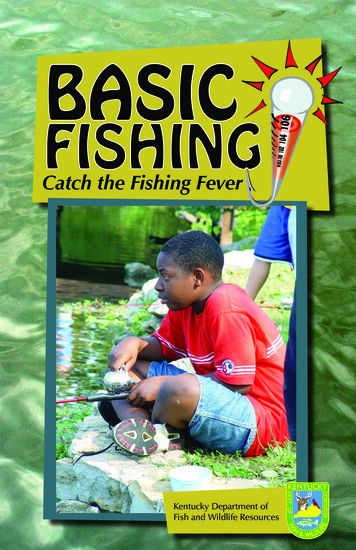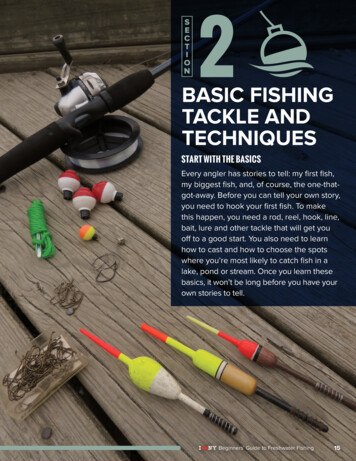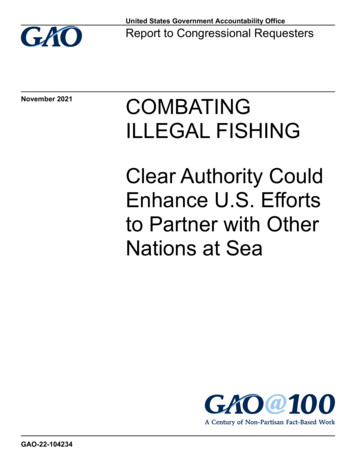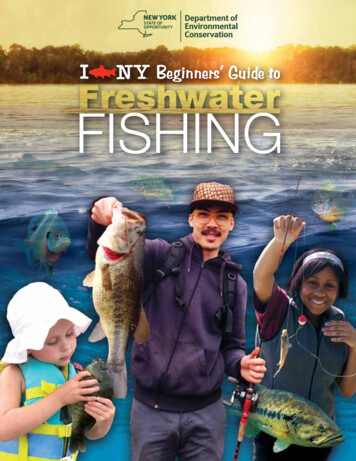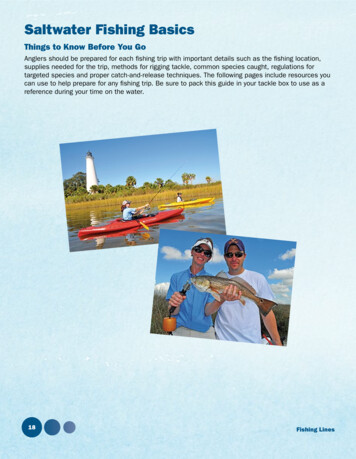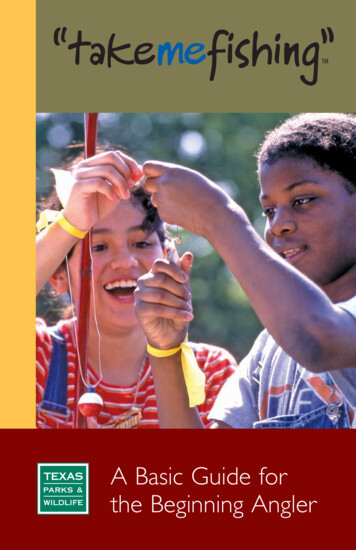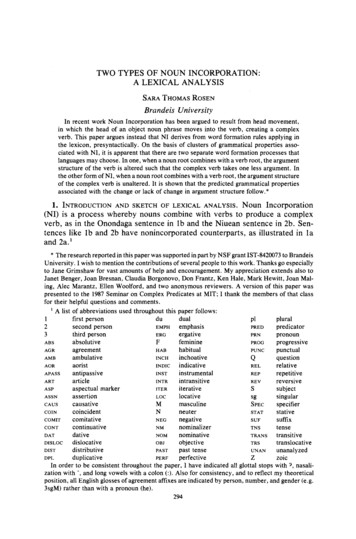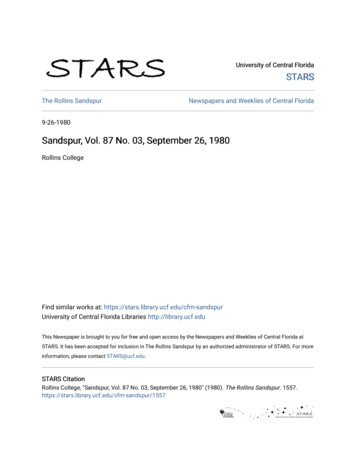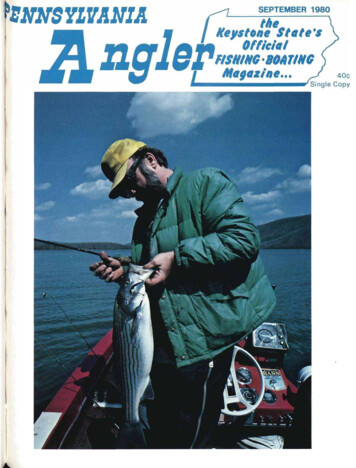
Transcription
SEPTEMBER 1980A BfflepKeystone State'sOfficialFISHINGBOATINGMagazine. 40CSingle Copy
THINKING AHEAD —I n anticipation of our completion of the inventory and survey ofstocked trout streams by the end of this summer, subsequentanalysis of these data and the ultimate application of new streamclassifications, the staff conducted a workshop in July for membersof the Commission. The workshop was aimed primarily at potential changes in directionof special regulations and will be followed up with several more meetings. Quite often inPennsylvania, special regulations had been imposed on waters where angling mortalitywas not limiting the population, but habitat and environmental factors were influential.Despite the "biological failure" of many areas, they became popular. It is obvious to usthat the rationale for establishing specially regulated trout fisheries should includerecognition of some of the social values of such areas.Our discussions are along the general lines of taking into account "quality"angling which must include the value of the experience to the angler. The objectives ofour new program proposals are:I. To provide the opportunity to fish over an essentially "natural" population oftrout where hatchery fish, harvest and hooking mortality are not factors inthe population structure.II. To provide the opportunity to fish over a dense population of wild troutranging in size from 10 to 14 inches.III. To provide an opportunity for a high catch rate by angling over a densepopulation of hatchery trout in a relatively natural environment.IV. To restrict the loss of fishing quality.V. To be responsive to the identifiable needs and preferences of a distinct groupof anglers.Obviously, the achievement of these objectives will not be simple. We are goingto attempt to have new ideas in place in 1982 and hope to use a great deal of calendaryear 1981 for getting public input through a series of regional public meetings.I urge you to read carefully Del Graffs well-written article: "Some Thoughts onTrout Management in the '80s," beginning on page 16 of this issue. We are thinkingahead and look forward to the exchanges of views with our angling public.Ralph W. AbeleExecutive Director
Pennsylvania AnglerPennsylvania's Official Fishing & Boating M a g a z i n ePublished Monthly by thePENNSYLVANIA FISH COMMISSION, COMMONWEALTH OF PENNSYLVANIARichard L. Thornburgh, GovernorMEMBERS OF THE PENNSYLVANIA FISH COMMISSIONLeonard A. Green, PresidentWalter F. Gibbs, Vice PresidentWilliam O. HillErieJohn A. HugyaJohnstownCalvin J. KernWhitehallRoss J. HuhnRobert L. MartinJerome E. SouthertonJ. Wayne YorksSaltsburgMEMBERS OF THE BOATING ADVISORY BOARDNicholas Apfl, ChairmanClayton BuchananPittsburghSherwood KrumCharles ChattawayMonongahelaLeon LyonVolume 49 - No. 9CarlisleRenoBellefonteHonesdaleBentonFairless HillsHawleyBellefonteCONTENTSSeptember, 1980Striper Fever by Wes BowerFrances Slocum Lake by Gerry KingdomEconomy Spinnerbaits by Frank LucasTrout Management in the 80s by Delano R. GraffStorm Water Pollution by David R. ThompsonTrials of the Evening Angler by William C. AckermanThe Incurables by George L. HartingWeather or not to Boat? by Virgil Chambers812141620222528ON OUR COVERSFRONT COVER: Ranny Isenberg admires his eight-pound striper — a nice catchanywhere. At Lake Raystown, however, the State Record catch standsat an even 19 pounds! Starting on page 8 of this issue, author Wes Bowertells about the "Striper Fever" sweeping the Raystown environs.Photograph by Gerald AlmyBACK COVER: The crappie is generally regarded as a spring favorite, butknowledgeable anglers will find the scrappers ready to do battlein late season too. They're great sport when taken on a light fly rod.Photograph by Lefty KrehMONTHLY COLUMNSLEAKY BOOTS.2MEALS FROM THE CREELWATERSIDE WANDERINGS4STREAM NOTESANGLER'S NOTEBOOK32630James F. Yoder, EditorOSTMASTER: AH 3579 forms to be returned to the office of the Pennsylvania Fish Commission, P.O. Box 1673, Harrisburg, Pennsylvania, 17120.A"e Pennsylvania Angler, (ISSN 0031-434X), Copyright 1980, is published monthly by the Pennsylvania Fish Commission, 3532 Walnut Street,O risburg, Pennsylvania. Second Class postage paid at Harrisburg, Pennsylvania and at additional mailing offices. Subscription rates:] * year— 4.00; Three years— 10.00; 40 cents per single copy. Send check or money order payable to the Pennsylvania Fish Commission. Do t Send Cash. Changes of address should reach us promptly giving both old and new addresses, including both zip codes. Subscriptionsres 1Ved and processed by the end of the month will begin with the second month following. The Pennsylvania Fish Commission will not assumeP nsibility for unsolicited manuscripts, photographs, or illustrations while in their possession or in transit. Communications pertaining to thejja8azine should be addressed to: The Editor, Pennsylvania Angler, Pennsylvania Fish Commission, P.O. Box 1673, Harrisburg, Pennsylvania."solicited materials, manuscripts, or photos will not be returned unless accompanied by a stamped, self-addressed envelope for their return.
"FISH CROSSING"One day while driving south on Route220, between Bellwood and Altoona, Inoticed an object on the road ahead of me.It seemed to be moving and at first Ithought it was a small groundhog or someother animal that was hurt, but as Iapproached it, to my surprise it was a nicesized bass flopping around! The traffic wastoo heavy to pull off, so I continued on mytrip. On my return trip the fish was gone.After telling some of my buddies what Iencountered they sorta call this place a fishcrossing now. After all, there was a smallstream at the site.SHERMAN SCOTTBlandburgLOST ROD —I enjoy reading the Angler and haveread it for as long as I can remember. Hopeyou can help my desperate case. We hadjust finished fishing at Big Deer Creek(near Butler in Allegheny County) onApril 12, and decided to go home. Whiletaking off my hip boots, I leaned my ultralight against the car and then I forgot it. Iam in an urgent need of finding it. I doknow two people who were fishing near mewere named "Rege" and "Matt." The rodand reel were lost near the racquet club, afew hundred yards upstream on a dirtroadside. I would greatly appreciate yourhonest readers' help.Your desperate reader,BRIAN P. SALAMON115 7th Street Ext.Trafford, Pa. 15085SHAME ON US!After reading the last several issues ofthe Pennsylvania Angler, I was appalled tofind that you are practicing the same pollution that has been plaguing most of thecommercial magazines. The pollution I amspeaking of is the concentration of fishermen that you have been forcing ontoportions of our finest streams.In only the last four months you havepublished no less than four articles aboutor alluding to Penns Creek. This irrespon-sible type of journalism must be stopped.In the last three years there were fourarticles in major magazines, (PennsylvaniaAngler was one) that not only lauded andplauded Penns Creek but actually invitedand pinpointed fishermen to a certain areaat a specific time (The Drake Hatch). Thiswould not be nearly so appalling if youadvertised public or Fish Commissionground, but the land you spoke of isprivately owned. How much can and willthe private landowner take? Because Iknow Penns Creek and so many PennsCreek landowners, I can tell right now thatwe are in grave danger of losing two greatstretches of Penns Creek from public fishing. Both of these areas are so strategicallypositioned on this creek that in my opinionit will all but close the great Penns Creekthrough a domino effect.We ask you to please use journalisticalrestraint before printing another singlearticle that is intentionally or unintentionally designed to concentrate fishermen onany stretch of any stream. The damagealready done has set us ahead twentyyears. Please don't continue us on this selfdestructive course. We already have toomuch pollution to fight now.GERRY LIPKAQuarryvilleI can appreciate Mr. Lipka's feelingseven though I think he's overreacting. Thatthere is a shad fly hatch on Penns Creek isa secret? In one month, March to be exact,Penns Creek is mentioned in articles inthree magazines with national distribution.This is the nature of outdoor writing, folkswrite about "name" streams.It is a great concern to the PennsylvaniaFish Commission whenever we have anangler/landowner conflict which can resultin closure of streams. We try not to attractanglers by focusing all attention on onearea. Still, we have an obligation (and anglers are interested) to provide "service"articles which point out good places to fish.Penns Creek does receive a lot of attention;it's a good place to fish. I suspect that if thePennsylvania Angler never published another article, there will still be a great manyanglers attracted to Penns Creek. TheCommission has purchased a section ofPenns Creek; it is under special management. We recognize that Penns Creek isvaluable to our statewide program; we'dlike to minimize landowner/angler conflicts. If we had specific sites and information, we might be able to answer moreintelligently.In short, we (the Commission) don't wantto exacerbate angler/landowner conflicts;however, we can't control outdoor writers. Isuspect that being mentioned in magazinesis only one of many reasons why so manyfolks fish Penns. What about our stockingprogram? What about wild trout? Whatabout good fly hatches? All these factorsadd up to attracting people. Yes, PenCmay be overpublicized, but that's only pa'1 e'of the attraction!IliSlDelano R. Graff, Chi4 mDivision of Fisheries huis in*»«!UNDERSIZEHaving just renewed my 3-year su f.i!scription for more years of pleasurablereading and information in the Angler, ' 'feel it's time for my annual comments.jf8a2 orMy buddy and I fish the Susquehanfl j,around and above Hallstead and havf *found that the river is alive with walleye* (in the 12- to 15-inch size but rarely does a" J-'angler take one of legal size. The exception,is the pool below the dam at Susquehanna j 'Would it be reasonable to lower the sizc ''limit on the stretch and avoid the tempta' 'tion to take these fish home? Smallmoutl1 'bass in this stretch have become almos1 *nonexistent although in my younger year* L this was one of the best spots. The same *j« 'true of rock bass and pickerel. Why is thiS' :I must say that in the last few years tW Rlriver appears cleaner and perhaps there i*some hope of a revival. Is a biologica' %survey in order?The practice of having one's fishinglio,license enclosed in a plastic holder tha'must be displayed is, in my opinion*\archaic and a prime nuisance. I am foreve'1*0poking holes in my water-resistant jacks'1 i»alor pinning the thing on my hat windpromptly blows off or leaving it on my sh'«t other shirt (which I leave back at tfflbiacottage). Why can't Pennsylvania folio*1Xthe lead of other states which simpSs Vo,require that the license be carried on one «f,person to be produced whenever requestedby a patrolman? It isn't likely that I would1forget my wallet!sufIn answer to Robert Nemec's questiCabout giving plastic worms an attractive Mi,aroma I suggest putting a few drops } %cheap smelly castor oil on them. I find th'sworks well on natural worms and should o so on plastics. Wash it off before you pujthe worms back in the tackle box as the o 'tends to get sticky.G(This epistle has gone on long enough sowill close before any other questions oecujto me as they undoubtedly will as soon as\get this in the mail.\Keep up the good work and good fishing «mto all of the fishing fraternity!«tcCLIFTON W. R U S S E TMt. Vernon, N.Y.tiviloifroDear Mr. Russell: »iYour questions concerning smallmoi"&bass and the small size of the walleye in 'upper Susquehanna River have been (t'tir,ferred to this office for reply. Due to a Iaccof data on that particulary fishery, I may r ;not be able to answer your specific que*' »1P E N N S Y L V A N I A4ANGLE*JL
end* "s but will offer the information that isp a t e n t l y available.I batches of sublegal walleye in the upper. l uehanna River have puzzled anglers for. nuinber of years. As you mentioned inH i U r ' e t t e r ' 't ' s n o t a t a 'i unusual to catch, »ny 12-1 0 15-jjsh with only an occasional. . P*r; my ownown fishing experiences cerconfirm this. Last summer, scalees were collected by anglers and sentoffice for age analysis. Some anglersvibl' * that these sublegal fish were slowr, 11 0w ng walleyes that may never attain theSal s ; z e j n e s c a i e s that were collectednni n sublegal fish showed these fish to beav« A to 2'/2 years old and indicated growthyes *«s that were compatible with the state: a* „ erage. From this small sample it appearsioHf-*' those 12- to 15-inch walleyes, arena '-growing and not yet sexually mature;iZe. CeP* perhaps for some males that may be,ta- J aHy mature during their second year),uth*efefore, by lowering the minimum size aso ! vton" suggestmany ofmortalitythese fishwouldtheybear« fleetedto fishingbefore5 i'. ((iVe had an opportunity to spawn. If all ofis' 0se sublegal walleye are young and fasttW lj ng, then where are the older mature;is [J* and what happens to all those 2 /2 yeara'1 S 14-inch fish that were caught and. le»sed last year? Unfortunately, I don'ting ,. w the answers to these and other ques,at ( "is at this time, but am confident that theDft § tVey that will be conducted on the upper/e Nuehanna River this summer willc6' H L'de t n e necessary data required tod1 y * e accurate statements concerning the»y (er'rJ'. During this survey fish-sampling\fi oniques will be employed that are not as sb*86*1 a s t n e a n 8 l e r ' s r o d afl d, therefore,jiy y «ld reveal the true nature of the fishery.B'j if0*1, a u e s t i o n s concerning the abundancee. it. *mallmouth bass will also be addressed*'ng this survey.lIH,you would like to accompany us on thes j/vey, please send this office your tele , ne number so we might let you knowenthefieldwork will take place.Robert E. MoaseFisheries TechnicianDOWNHILLSI ahe Youghiogheny Reservoir has, overC Past 15 to 20 years, gone downhill as(v. a s the smaller species of fish are„ cerned. Namely, the perch, crappie,(j ' The main reason is very little protecH e cover from the larger species, thenI ti0Pik*i musky, bass, etc. My soluI fr n would be to take the discarded tires' 'nil'11 " l e J u r ky a r d o n Route 40 only a few!t Q e s from the lake and wire 8, 10 or 12 Sether and lower them into the lake attj e r e nt areas. This would make use ofc Sra ' P r o v 'de a haven for perch, rock bass,j Ppies, etc., inside them. They would lastn8 time, be nonpollutant, and increaseE P T E M B E R —1 9 8 0fishingpleasure.IT PAID OFF!CHARLES SCHWERN. VersaillesDear Mr. Schwer:Your letter to the editor of the Anglerconcerning the Youghiogheny Reservoir hascome to my attention. I am well acquaintedwith some of the problems at the reservoir,and also of the use of artificial reefs toattract fish. However, in the case of the"Yough," the use of fish attractors won'treally solve the problems that have caused adecrease in the fishery. As you are probablyaware, the main, overriding purpose of thereservoir is for flood control. The Corps ofEngineers then considers the use of thewater stored during the spring and earlysummer months as dilution water to supplement the natural runoff in the lower riverand Monongahela River. Recreation andfisheries are third in line to be consideredand usually suffer because of this factor.The density and relative size of the fisheryin the reservoir is dependent on threefactors: the water quality in the impoundment, the smallest volume of water in thereservoir during the year, and the changesin water level.Every year, the reservoir is drawn downseverely to allow for flood water storageduring spring runoff. This act causes problems with consistency in water quality andthe density of the fish population. Duringthe last few years, the drawdown has beenso severe many of the fish in the reservoirhave been literally flushed into the streambelow. As you might suspect, this activityhas continually reduced the fish population,and reduced the productivity potential ofthe water in the impoundment.The use of fish attractors may helpattract those fish remaining, but will dolittle to increase the number of fish presentand their ability to reproduce. In actuality,a large number of such devices could have anegative effect on the amount of fish in thewater, and may only increase the chances ofcatching fish for a few years. Another problem with installing these fish attractors iswhether or not the Corps of Engineerswould permit the use of these devices.Our staff will be sampling in the reservoirthis year and next in order to determine therelative health of the fish population. Afterour survey, we will be proposing certainchanges in the operation of the dam andmanagement of the fisheries. If we can getsome concession from the Corps at thattime, we may be able to re-establish a betterpopulation of fish, and then look at the useof attracting devices such as groups of tiresor anchored brush piles. Thank you foryour interest in the fishery at the Yough. Ifyou have anymore questions or suggestionsconcerning this matter, please contact me.C. Blake Weirich,Area Fisheries ManagerMy two sons and I took the advice inyour April Angler. The enclosed AnglerAward application shows the results. Zanenot only caught the roe shad described butanother almost its equal. In all we boatedseven bucks, two roe and had two bucksand two other roe hooked.GENE FURRYShippensburgSCENTING PLASTIC WORMS —Here is the answer to Robert Nemec,May issue. Here is the formula that I useon plastic worms and twisters. Anyone whoknows anything about the new soft wormsand twisters knows these baits pick up anytype scent that may be on your hands.So, if you handle gas or oil for youroutboard motor, the worms will pick up thescent.Use 1 part oil of Anise to 7 parts mineraloil. These can be bought in the drug store.This oil goes a long way; so, to coat 100worms or twisters, I use '/i teaspoon oil ofAnise to 2 teaspoons mineral oil. Put thisall in a plastic bag with worms and mix.After this I put my worms in small plasticsandwich bags.CHARLEY YEAGERMt. CarmelCONTRIBUTION —Enclosed is a personal check in theamount of twenty dollars. This is a contribution to your agency in memory of afriend, Howard Worrell, who recentlypassed away.Mr. Worrell, formerly of Hyner, Pennsylvania, was a fine sportsman and hethought very highly of the entire effort putforth by the Pennsylvania Fish Commission.Please use this contribution for researchin fish culture.M R . & M R S . BRIAN B. BURGERBeech Creek, Pa.IN AGREEMENT. . .Hats off to Chief Graff! (May '80Angler — The Great Kiddie Contest)As a part-time elementary school teacher, I have seen the results of the everincreasing competition among our youngpeople. I am very glad to see that theCommission has leadership which is awareof attitude development and cares enoughto say something about it. Thank you!LARRY BROWNMillerton
lh,Waterside Wanderingsby Linda SteinerifLf you want to do something that'sreally nerve-wracking, try fishscouting from a bridge. Sure, it's aneffective way to locate fish, butsometimes I think you're better off notknowing what's down there.It had been a mediocre fishing dayin late summer, and four of us werewading in shorts and sneakers in thelukewarm bath the big creek hadbecome. The clear water shimmeredin the afternoon sun as I climbed up tothe roadway to our car to get a longsleeved shirt, although too late tocover my sunburn. The other gal and Iwalked out on the bridge to watch ourhusbands fish. Swallows dipped overour heads and we could see their mudnests on the girders under our feet, forit was the sort of steel bridge with"holes" in it, through which the watercan be seen flowing below.The two of us leaned lazily againstthe railing with our rods, as it hadbeen hours since any traffic hadpassed over this bridge between themountains. Everything could be seenso much more clearly from up therethan when we were fishing below. TheWhitewater riffle at the head of thepool fell away to a deep hole that laybetween the farthest bridgeabutments, a hole so deep that theedges faded gradually to a blue-greengloom. It was the kind of pool thatkeeps anglers awake nights. There'salways a mystery: just how big a fishis down there? Of course, it was alsothe local kids' swimming hole, with arope swing tied to a tree limb juttingout over the water.We watched the water slide past,the bottom showing through brownand rock strewn, the surface sparklingsunlight up at us. The current broke4and bent the picture in places, but inthe slick water glides we could seeevery detail, including the fish. Wewatched our husbands cast andfollowed the progress of their bait. Wereally could learn a lot from up there."Doggone it, I can't hook them!Can you see what's taking myworm?""You're retrieving it right througha big school of minnows!"Dozens of pale, darting formsconverged on the night crawler as itwas pulled back to the fisherman. Bythe time he saw it, only the bare hookwas left. One of the bigger minnows,for they were in the pool in all sizes,from various spawnings, would grabthe worm by the end like a puppy doesa sock and tug on it. The angler wastrying to set the hook in a mouth thatwas too small to take it in and losinghis bait to waiting hordes of minnowsin the bargain."Slow down your retrieve, there's anice bass following it," my friendcalled to her hubby. "Oh, you missedhim!"It became a sort of game, the two ofus scouting for the biggest fish anddirecting the angler's casts. When weshaded our eyes and searched for fish,we realized there were hundreds in thehole, from the minnows up to"keeper" smallmouth bass, testimonyto the productivity of the river.Swarms of minnows and smallchubs dotted the shallows and the firstfoot or so of water over the deep hole.Bass cruised below or sliced amongthe baitfish, scattering them. Fromabove, we could tell they were bass bythe dark trailing edges on their tailfins and their large jaws.Smalimouths were suspended as farP E N Ndown as we could see in the deepgreen water, and sometimes theychased and swirled after ourcompanions' lures, but didn't alwaysstrike them. Of course, that wasn'talways the bass' fault: sometimes itwas our coaching."Watch it, he's almost got it,careful now . . . Oh Oh, he took it! N"'you pulled it right out of his mouth!"It was no wonder the fishermen wereshaking when they tied on new hooksI crossed the roadway to thedownstream side of the bridge after 3car, the first that afternoon, passedby. The driver had stopped on thebridge to ask how the fishing was. H6was in no hurry and there was noworry about traffic stacking up behif"him. I could see that downstream thehole became shallower and rock barsspread out like long fingers from thetail of the pool, with deep runsbetween them. All along theoutcroppings were fish, not so manybass as in the hole, but a greatervariety.Long suckers lay motionless on thegravel bars or moved upstream alongthe rocks, bulbous mouths picking f ffood among the debris. When theyrolled and flashed their golden flanksup at us, we realized how big theywere. Wouldn't it be fun to hook oneof those? We dangled our lines off thebridge, little pieces of worm laid do "in their paths. How could they missthem? But they passed by,"vacuuming" up everything else!Among the suckers we could seemany smaller fish flashing. Theylooked like trout at first glance, butwhen they turned we saw the fallfish!silvery scales and deeply forked tailThey took the worms greedily, thoughY L V A N I AANGLE
i nd little jigs that we bounced on theWorn, giving us a lot of fight forI their size.Sometimes all the splashing activity ' a hooked fish does just the opposite f scaring the rest. At times it attractsother fish to the scene, like the shadow* e could see easing upstream, the slimt0rpedo shape that took a waitingj? sition just below the strugglinga"fish. It was a pickerel, but all theP'kes seem to have the same sinister*ay of suddenly appearing, with theirMalevolent eyes and toothy jaws. It* a s also a big pickerel, and my fingersumbled tying on a plug. I cast itj Wnstream, working it up past thesh- I'm not sure if being able tothatch the action from above was ae'p, because when the pickerelleaked for the 1 ure, I flinched.But when I looked again, he wasst'H there, holding in the current, andev'dently even more excited by hisJfear miss. His tail and fins wereanning furiously. I cast again butgrieved more slowly, twitching theUl"e now and then. He followed? hind it, wolflike, then curled his dy into a quivering " S , " poised likeasnake. His strike came so fast I"early missed it, but the fish hadtactically hooked himself.E P T E M B E R—1980After I released the pickerel, Istopped to peer into the pockets ofdeep water that had formed by thescouring action of the current aroundseveral bridge abutments. Sunfishwere there, their tail fins light-coloredwhen seen from above, and a few redeyed rock bass. When I reached myfriend again, she was still trying to getthe suckers to bite. It was then that wesaw them, moving up through thedeep runs and over the gravel barstoward the hole like beef cattlecoming through a pasture: carp.Their olive-gold bodies looked liketailed footballs as the carp grazedcloser. Now that would be somethingto catch! But we certainly couldn'tmanage it from the bridge, so weyelled to our hubbies and pointedtoward the fish. They cast to them,even hooked a few, but in the swiftcurrent at the tail of the pool therewas no way to hold the big fish.Perhaps the smaller fish thought thecarp's splashing was a feeding spreethey shouldn't miss, because suddenlydozens of fallfish and bass wereswirling with them.As I watched, another large-bodiedfish appeared, rising up from thedepths of the hole. Another big carp, Ithought, and called its position to thefishermen. As it got closer, I could seethe dark-tipped tail and gaping jaw."Omigosh, it's a huge bass! It was agiant-sized smallmouth, dwarfing theother bass and nearly as big as thecarp. We both shouted, "Cast, cast,he's right below us, right there!"The two anglers missed their marksin the excitement: one cast was short,the other wild. Bass fever! "He's stillthere, cast again!" The lunkercontinued to cruise the tail of the pool,but the next casts left one hung up ona rock, while the other went a bitwide. The big bass, which hadn'tgrown to that size by hanging aroundgiving fumbling fishermen too manychances at him, simply sank into thedepths again.No amount of further casting,changing lures or bait or peering offthe bridge could locate the fish again.But the sunlight still gleamed on thewater, the swallows winged around usand the creek glided past as placidlyas ever. It was only we who wereshaking, because now we knew justwhat was down there. We found thebig bass by "fish watching," but thatwas still a long way from catchinghim. We never did get him, but then,that would have spoiled the mystery ofthe deep hole. Or would it?5
MEALSfrom theCREELby Margaret Karch ZaimesW hen the leaves changed color andbegan to drop, my grandfather waitedimpatiently for the first killing frost. Itwas at this time he began slaughteringhis hogs and preparing ham, bacon,scrapple, etc., for winter use.He seemed to know, instinctively,when this day would arrive. Ironkettles, brining barrels and all theother equipment needed was hauledout of storage and readied for thisall-important time of the year.The annual ritual of selecting theproper seasonings to mix into the brining solutions and finding the right kindof wood to be used in the smokehousewas something I looked forward to as achild.I was not old enough to help mygrandmother scour all the equipmentbut I was frequently allowed to tagalong while my grandfather purchasedthe special grind of pepper and theproper kind of salt and to walk by hisside through the orchard while heselected apple and cherry wood to addto the hickory he had accumulated forsmoking.Eagerly, I waited for him toannounce that "tomorrow" was the bigday. The first porker would be slaughtered and the process would be underway. My grandfather was one of manyfarmers of that period who brined andsmoked fish or meat to preserve it forthe long winter months ahead.Solving the mystery of when andwhere the salting and smoking of foodsbegan is like running up a blind alley— there are no records. Primitive mansatisfied his hunger pangs with proteinoff the hoof and fin before the discovery of fire. In all probability, as helearned to control fire and cook hisfood, he accidentally discovered thatsmoke added flavor and acted as atemporary preservative. Where saltingand brining entered the scene is alsoobscure but chances are it existed incoastal areas before smoke rose fromthe first fire. The blending of the two6resulted in a successful marriage thathas endured since its origin to addmuch to the cuisines of the world.At one time, brining and smokingmeat or fish was done at home. Asprosperity swept our country andcommercially smoked fish appeared inour markets, the home methods wereshelved and brining formulas forgotten.Today, with rising food costs, moreand more of us are returning to"grandfather's" methods of preservingthese delicacies.The nice thing about smoke curingat home is that no expensive equipment is needed. Almost any nonmetallic container large enough to hold thefish and brine will do. I frequently usea widemouthed two-quart jar or one ofthose inside-glazed pottery bean potsto brine my fish.My grandfather swore by a briningsolution with enough salt dissolved inwater to float a raw egg (of course, youleave the egg shell on). To this headded spices and a sweetener.To make a brining solution similarto his, 1 use:1 gallon boiled and cooled waterKosher salt or pickling salt'/t cup brown sugar (packed)1 tbsp cracked or coars
The Incurables by George L. Harting 25 Weather or not to Boat? by Virgil Chambers 28 ON OUR COVERS FRONT COVER: Ranny Isenberg admires his eight-pound striper — a nice catch anywhere. At Lake Raystown, however, the State Record catch stands at an even 19 p
